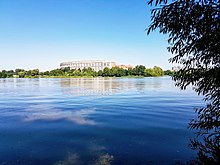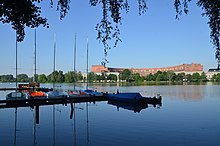Volkspark Dutzendteich
The Volkspark Dutzendteich is the largest park in Nuremberg around the Kleiner and Großer Dutzendteich as well as the Silbersee.
location
The Volkspark Dutzendteich is located in the southeast of Nuremberg and stretches between Münchner Strasse, Bayernstrasse to the exhibition grounds, the number ponds and the Nuremberg campsite in the south. In the east it extends to the sports and event grounds with the arena hall and the Max Morlock stadium . The Volksfestplatz in the north and the small settlement built after the Second World War on Oskar-von-Miller-Straße do not belong to the Volkspark - but the riverside area along the congress hall.
In the north, a pedestrian bridge (donated by the patron Kurt Klutentreter) leads from the Volksfestplatz over Bayernstraße to Luitpoldhain . Together with the Luitpoldhain, the Volkspark has a size of 133.6 ha.
history
As early as the 17th century, the Dutzendteich developed into a destination for excursions: in 1638 the license was granted for the first time and in 1713 the “Wirtshaus am Dutzendteich” was built on the north-west bank. In 1813 you could go on gondolas and barges, go sledding in winter or skate on ice skates.
After the site was sold, the "Dutzendteich-Park-Actiengesellschaft" was founded in 1823 with the aim of maintaining and beautifying the Dutzendteich as a "place of recreation and pleasure ...". It existed until 1941. The area was opened up to traffic: the Dutzendteich railway station was built in 1870, the horse-drawn tram started running in 1882 and was replaced by the electric tram in 1896. More inns settled in the neighborhood and instead of the "Wirthaus am Dutzendteich" the "Park-Café-Wanner" was built in 1899.
In 1899 and 1905 the areas around the Dutzendteich were incorporated into Nuremberg.
In 1906 the state exhibition was held at the Dutzendteich site. As an attraction, a lighthouse with elevator and viewing platform was built on the south bank, which also emitted the typical headlight signals. The popular building was blown up by the National Socialists in October 1935 for the construction of the congress hall.
In 1912 the zoo was located on part of the site of the anniversary exhibition and at the so-called number ponds.
In the area east of today's Volkspark, a sports and recreation area with the municipal stadium, today's Nuremberg Stadium, was built from 1923 . This included the zeppelin field, on which Ferdinand Graf von Zeppelin landed in an airship in 1909. These areas are not in the area of the Volkspark.
The Nazi regime chose Dutzendteichgelände and Luitpoldhain for their Nazi Party Rally Grounds project - not least because of the good transport links. The lighthouse had to give way for the congress hall and the Dutzendteich was filled up at this point. The construction of the Great Road cut the water into the small and large dozen ponds. Further south, construction of the German Stadium began and the construction pit dug. The Nazis' plans also included the neighboring Zeppelin Field and the March Field. When the war began, construction work ended in 1939/40. Over the years, the excavation pit for the German Stadium has filled with water. This is how the Silbersee was created . The entire area of the Dutzendteich area and the Luitpoldhain are under monument protection.
The Dutzendteich area became a local recreation area again after the end of the Second World War. By 1951, the southern part of the Silbersee was filled with waste, hazardous waste and rubble down to ground level, and the Bauernfeindstrasse high-level landfill, today's Silberbuck , was built. In 1962 the 356 m high mountain was greened. Silbersee and the Silberbuck viewing mountain became part of the park.
today
The "Volkspark Dutzendteich" is used today on the banks of walkers, cyclists, skaters and joggers; On the water there is a boat rental with 60 pedal boats and rowing boats in the summer months and you can go ice-skating in winter . The club and boathouse of the Nuremberg Yacht and Sailing Club is on the north bank.
The Documentation Center of the Nazi Party Rally Grounds has designed a path through the grounds around the Dutzendteich, equipped with information boards. The area serves as a protection zone for numerous animals and plants on the so-called Red List. A nature trail with 15 stations has been set up for walkers.
Twice a year, attracting major events: The race at the DTM - street circuit Norisring and the Music Festival (formerly "200 Miles of Nuremberg.") Rock in the Park , several days around camp in which thousands of fans around the lake.
Partial areas of the Volkspark had to be repeatedly asserted against the expansion plans of the exhibition grounds adjacent to the south , other park areas between Grosse Strasse and Silberbuck were built with the exhibition's infrastructure facilities.
Individual evidence
- ↑ http://www.nuernberginfos.de/gewaesser-nuernberg/dutzendteich-nuernberg.html
- ↑ http://www.dutzendteich-bootsverleih.de
- ↑ Information system on the Nazi party rally grounds
- ↑ http://www.nuernberginfos.de/gewaesser-nuernberg/dutzendteich-nuernberg.html
Web links
Coordinates: 49 ° 25 ′ 51 ″ N , 11 ° 6 ′ 54 ″ E



